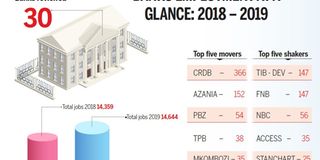The ups and downs in jobs creation in banking sector

Dar es Salaam. The number of jobs in banking slightly increased last year, compared with 2018, although individual banks recorded mixed trends in the matter.
An analysis done of financial statements of 30 commercial banks for the fourth quarter of last year showed that, generally, the number of jobs in the industry rose to 14,644 last year from 14,359 in 2018, a difference of 285 job positions.
This upward trend came at a time when most banks were recovering from a challenging credit market, business turbulences and financial accounting rearrangements following adoption of the International Financial Reporting Standard (IFRS-9) in January 2018.
The financial statements showed that nearly half of the reviewed banks recorded an increased number of staff; others recorded job cuts - and yet more made no changes.
According to the analysis, some banks increased the number of their workers due to expansion of their business activities - particularly opening of new branches - while others cut jobs due to adoption of modern technologies, includingdigital banking. Also, some banks were implementing costs-cutting measures as they adjusted to a changing business environment.
However, the adoption of new technologies - which enabled most bank services to be conducted from outside banking halls- slowed the creation of direct jobs in the industry.
Other factors for the low jobs creation margins, the analysis revealed, included shifting of workers from one bank to another while some workers reached retirement age or resigned for various reasons - and were not replaced immediately, or at all.
“It seems that, since the adoption of new technologies and innovations in offering banking services, most banks have kind of frozen jobs creation after adopting mobile and Internet services,” the analysis showed.
Jobs increase
The reviewed financial statements show that ten banks managed to create new jobs last year, with CRDB Bank - which is listed with the Dar es Salaam Stock Exchange (DSE) - being in the lead on this.
CRDB Bank is one of the most profitable banks in Tanzania. It created 366 new employment opportunities last year, rising to 3,467 from 3,101 in 2018.
Azania Bank became second after it created 152 new jobs last year, rising from 359 to 511 employees.
However, the increase in the bank’s employees was a result of its merger with Bank M, which was put under Bank of Tanzania (BoT) supervision following a liquidity stress.
The central bank gave the nod for the two banks to merge in January 2019 by transferring all customers, employees, assets and liabilities of Bank M to Azania Bank.
The People’s Bank of Zanzibar was also a top performer after creating 54 new job positions in 2019, rising to 410 from 356. It was followed by TPB Bank, which brought in 38 new workers to hit the 926 mark in 2019 from 888 workers in the previous year.
According to the financial statements checked, Mkombozi Commercial Bank (MKCB) created 35 new jobs - to 169, from 134 staff - while Equity Bank created 29 new jobs, to reach a total of 409 employees from 380 during the period under review.
Other banks which recorded an increased number of employees were Diamond Trust Bank (DTB) Tanzania - which increased 17 jobs to reach 543 from 526 - and TIB-Corporate, which created 15 jobs to reach 141 last year, up from 126 in 2018.
NIC Bank also managed to increase its number of employees, to 117 from 108, while the number of employees at the CBA Tanzania bank grew to 162 from 157.
Job cuts
The financial statements also show that eight banks experienced job cuts with TIB Development, National Bank of Commerce (NBC) and FBN Bank placed on top of the list.
The TIB Development Bank was on top of the list after cutting 147 jobs to 160 by December last year from 307 employees at the end of 2018.
The bank - which faced much turbulence in 2018 and last year - ended up being merged with TPB Bank, which is owned by the government.
The second largest job cuts were recorded by FNB Bank. As of December last year, it had only 153 employees, compared with 236 at the end of 2018.
The National Bank of Commerce (NBC) Limited also joined the bandwagon after shedding 56 jobs, remaining with 1,155 workers by December last year, down from 1,211 in 2018.
Stanbic Bank - which is one of the largest banks in Tanzania - also reduced the number of its employees to 522 from 539 during the period under review.
The financial statements also show that Access Bank Tanzania cut 35 jobs during the period - to 386 from 421 - followed by Standard Chartered Bank, which reduced its employees to 283 from 308.
Barclays Bank Tanzania - which is rebranding to Absa-Tanzania, - slashed 22 jobs to 484 from 506, while Eco Bank Tanzania terminated 14 employees, remaining with 107 last year, as against 121 in 2018.
Mwanga Bank and Yetu Microfinance cut three jobs each during the period to 40 and 133 respectively, down from 43 and 136 respectively.
The DCB Bank reduced its workforce to 212 from 226, while KCB Bank cut nine jobs to 273 last year, down from 282 in 2018.
The Moshi-based Uchumi Commercial Bank reduced its workforce by five, to 39 from 44.
No job cuts or increases
The study further shows that only three banks - namely China Dasheng Bank, I&M Bank and NMB Bank - did not cut or increase their employees during the period under review.
In fact, the number of employees with NMB Bank remained the same, at 3,450.
For their part, the I&M Bank and China Dasheng remained with a total of 183 and 23 employees respectively during the period under review.




